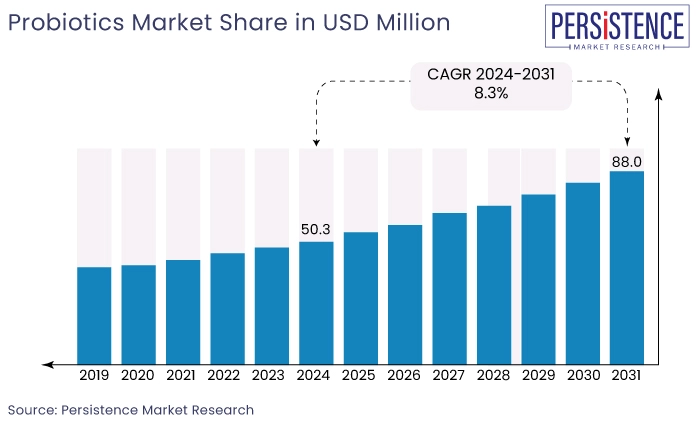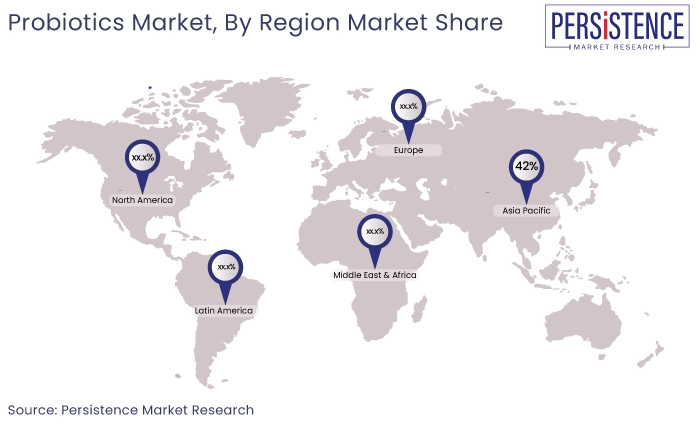Industry: Food and Beverages
Format: PPT*, PDF, EXCEL
Delivery Timelines: Contact Sales
Report Type: Ongoing
Report ID: PMRREP34636
The probiotics market, estimated to reach US$50.3 Mn in 2024, is expected to be valued at US$88 Mn by 2031. The market is expected to reach a robust CAGR of 8.3% from 2023 to 2031.
Key Highlights of the Market
|
Attributes |
Key Insights |
|
Market Size (2024E) |
US$50.3 Mn |
|
Projected Market Value (2031F) |
US$88.0 Mn |
|
Forecast Growth Rate (CAGR 2024 to 2031) |
8.3% |
|
Historical Growth Rate (CAGR 2019 to 2023) |
7.7% |
The market has been experiencing significant growth in recent years. The market is driven by various factors, including the growing awareness about the health benefits of probiotics, such as improved gut health and overall digestive function.
According to market analysis, the probiotics market growth sector was valued at US$3.45 Mn in 2024 and is projected to reach US$88.0 Mn by 2031, exhibiting a CAGR of 8.3% during the forecast period.
Probiotics is also gaining popularity as a natural substitute for antibiotics, which act as growth promoters without causing potential risks to human and animal health.
Probiotics, are live bacteria and yeasts that are beneficial for gut health, are often included in functional foods and supplements to support the gut microbiome.
Additionally, the market is influenced by consumer preferences for natural products and preventive healthcare.
It is worth noting that the market is dynamic and constantly evolving. Companies are continuously developing innovative products to meet consumer demand for digestive health benefits.
The market is also influenced by factors like shifting consumer attitudes, purchasing behaviors, and technological advancements.
Historical Growth and Course Ahead
The probiotics industry has witnessed significant growth in recent years and is expected to continue its upward trajectory in the future. The market was valued at US$34.5 Mn in 2019.
The market growth was attributed to increasing consumer preference for natural products and preventive healthcare. People are more proactive about maintaining their health and preventing diseases. Probiotics are seen as a natural and safe way to boost immunity and ward off illness.
The market is projected to reach US$88.0 Mn by 2031, exhibiting a CAGR of 8.3% during the forecast period. Growing awareness about the health benefits of probiotics, such as improved gut health and overall digestive function, is pushing the market forward.
Moreover, a rise in the consumption of functional foods is another factor that is expected to bolster the market to the next level. Consumers are seeking non-pharmaceutical solutions or natural alternatives to promote a healthy gut and enhance their overall health.
This reflects a broader shift towards preventive healthcare and a focus on holistic well-being, showing rapid market expansion.

Increasing Consumer Awareness about Probiotics Benefits
Consumers are becoming more aware of the link between gut health and overall wellbeing. Benefits of probiotics are diverse. They are actively seeking products that can support their digestive health and improve their gut microbiome. This growing awareness and preference for gut health are driving the demand.
Rising Demand for Preventive Healthcare
There is a growing market trend towards preventive healthcare, with consumers seeking natural and proactive approaches to maintain their health. Probiotics are seen as a non-pharmaceutical solution to support gut health and overall wellbeing.
The demand for probiotic products is driven by consumers' desire to take control of their health and prevent health issues before they arise.
Increasing Consumption of Functional Foods
Functional foods, which offer additional health benefits beyond basic nutrition, are gaining popularity among consumers. Probiotics are often incorporated into functional foods, such as yogurt and other dairy products, to provide digestive health benefits.
The rise in the consumption of functional foods is driving the demand for probiotic products as consumers seek out products that can support their overall health and well-being.
Lack of Information and Awareness
Lack of awareness regarding the health benefits of probiotic foods and products among consumers can impede the industry. While there is growing interest, many consumers lack knowledge about the nuances required to identify and purchase probiotic foods.
This lack of awareness can hinder the market's growth potential. Efforts to educate consumers about the health benefits and their availability in various food sources are crucial to overcome this obstacle and drive growth.
Standardization and Quality Control
The probiotics sector faces challenges related to product quality and standardization. Ensuring consistent quality and viability of probiotic strains throughout the manufacturing process is crucial.
The lack of standardized regulations and quality control measures can lead to variations in product efficacy and consumer experiences.
Establishing industry-wide standards, quality assurance protocols, and regulatory frameworks can help address these challenges and ensure the reliability and effectiveness of probiotic products.
Expansion in Non-Dairy Products
While probiotics is commonly found in dairy products like yogurt, there is a growing demand for non-dairy alternatives. This presents an opportunity for probiotics manufacturers to develop innovative products such as plant-based yogurts, beverages, and snacks.
With these products, probiotics companies cater to consumers with dairy allergies, dietary restrictions, or those who prefer plant-based options.
Integration of Probiotics in Personal Care Products
Probiotics have shown potential benefits for skin health. Several products made of probiotics for women are gaining popularity.
As the skincare industry continues to focus on natural and holistic approaches, incorporating probiotics into skincare products like creams, serums, and cleansers can offer new opportunities for market growth.
Probiotic-infused personal care products can target specific skin concerns and offer a unique selling point for consumers seeking natural and effective skincare solutions.
Probiotic F&B Leads the Products Segment
Based on product, the probiotics market research indicates significant opportunities in the category of probiotic food and beverages. The food and beverage segment is expected to witness substantial growth, driven by increasing demand for functional foods and consumer consciousness towards nutritional benefits.
Probiotics are integrated into various food and beverage products to enhance taste, maintain good texture, and improve digestive health.
Probiotics manufacturers are fortifying food and beverage products with probiotic products to meet consumer demand for higher nutritional content and digestive health benefits.
For instance, in September 2023, SIG, and AnaBio Technologies joined forces to launch the world's first shelf-stable probiotic yogurt packaged in aseptic cartons.
The innovation paves the way for the development of more shelf-stable probiotic foods and beverages, prompting manufacturers to invest in further technological advancements for these popular product categories.
Lactobacillus to be the Primary Ingredient
According to the probiotics market report overview, based on ingredients, Lactobacillus is showing continuous growth for decades. Lactobacillus dominated the market in 2021 with around 65% of market share and is expected to grow with a robust CAGR further.
Lactobacillus, a type of probiotic strain, plays a significant role in the market. Lactobacillus acidophilus (L. acidophilus) is known as a probiotic or "good" bacterium that is present in the human stomach, mouth, vagina, and in some foods.
The "good" bacteria called L. acidophilus are helpful in the breakdown of food, the absorption of nutrients, and the defense against "bad" organisms that may cause infection or diseases.
Lactobacillus probiotic is integrated into a variety of products within the food & beverage sector, contributing to the growing market trend of functional foods. They are also used in the bakery sector, showcasing their versatility in various industries.
Lactobacillus strains are commonly used in probiotic products due to their well-established health benefits. These insights highlight the importance of lactobacillus as a key ingredient that fuels the market expansion of the of the probiotics sector.
Asia Pacific Becomes the Global Hub for Brands, Blossoms with 42% Market Share
In 2022, the probiotics industry saw Asia Pacific leading with a market share of approximately 42%, followed by Europe, and North America. The increasing number of health-conscious consumers and the growing demand for gut health products are the primary drivers of probiotic supplement demand in North America.
Manufacturers in the region are actively developing innovative supplements to meet this rising demand, while also offering customized probiotic options based on customer preferences.
Consumers are well-informed about the health benefits of probiotic supplements and place a high value on gut health.
The Middle East and Africa are emerging as promising markets for probiotic dietary supplements, driven by a significant demographic transition characterized by a young and working population that prioritizes health and well-being in their spending habits.

February 2024
Probiotics play a crucial role in human gastrointestinal health, restoring gut microbiota (GM) and reducing inflammation and pathogenic microbes. Studies show that probiotics can improve cognitive health by reducing inflammation and promoting cell-to-cell signaling.
However, safety concerns and potential risks must be closely monitored. The next-generation probiotics, like Akkermansia muciniphilia, regulate the metabolic system and gut barrier integrity, reducing lipopolysaccharides leakage and inflammation.
Further investigations, and microbiome characterization are needed to optimize the therapeutic potential of probiotic foods in preventing and managing cognitive deficits.
October 2023
APC Microbiome Ireland and Fonterra have announced a new research partnership aimed at enhancing gut health and developing novel probiotic products with health and wellness benefits for the human microbiome.
The research collaboration aims to develop new probiotic products that offer health and wellness benefits for the human microbiome. By combining their expertise, APC Microbiome Ireland, and Fonterra seek to unlock the potential of probiotics and contribute to the advancement of gut health research.
|
Attributes |
Details |
|
Forecast Period |
2024 to 2031 |
|
Historical Data Available for |
2019 to 2023 |
|
Market Analysis |
US$ Billion for Value |
|
Key Country Covered |
|
|
Key Market Segments Covered |
|
|
Key Companies Profiled |
|
|
Report Coverage |
|
|
Customization & Pricing |
Available upon request |
By Product
By Ingredient
By End Use
By Distribution Channel
By Region
To know more about delivery timeline for this report Contact Sales
